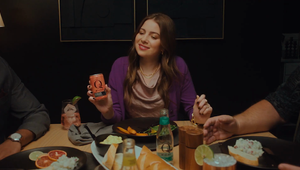
Vincent Geraghty on the Timeless Camera Dolly and Getting Scrappy with Virtual Production

Nashville-based production company Gear Seven pushes the limits of creativity, technology and possibility - and innovates like it’s nobody's business. Alongside a non-exclusive roster of directors and production capabilities, Gear Seven offers hardware, LED volume studios and virtual production via its sister companies Shift Dynamics and Arc Studios.
Gear Seven has teamed up with LBB to speak with agency production leaders about innovations in production technology and how it’s revolutionising commercial production. This series investigates the importance of education in this area for agencies and brands and offers a fun opportunity to nerd out on all things technical, while sharing memories of their most awe-inspiring and unforgettable moments on set.
The latest interview is with Vincent Geraghty, the head of production at Havas Chicago. With a passion for innovative content creation, he has built and led many integrated production teams at some of the top global agency networks, including Leo Burnett, Ogilvy and, since the start of 2022, Havas. Vincent’s focuses encompass not just the impressive creative that his teams produce, but also production models that help improve their production processes’ scalability and cost-efficiency.
Speaking to LBB’s Ben Conway, Vincent discusses the thrill and fear of shooting from a helicopter, organising a large-scale crowd scene for the launch of the Nintendo GameCube, and the timeless joy of seeing a camera dolly in action.
LBB> Throughout your career – what has been the most exciting or ground-breaking piece of new kit or technology that was introduced to you and why?
Vincent> Back in 1999, I did a 12-day running footage production for GM. Four of those days were helicopter shoot days with the addition of $150,000 a day just for the helicopter, pilot, support crew and helicopter DP. I got to go up in the helicopter for a running footage sequence shot on Mount Tamalpais, north of San Francisco. It was thrilling to follow the car up the mountain road maybe 75 ft above the road in the helicopter at 40-60 mph. When I was in the helicopter, an engine warning signal went off. Aside from scaring the hell out of me, we lost a half day while they flew a new helicopter out from San Francisco at the cost of another $75,000.
About 10 years later, large camera drones started to show up. While the original drones were still pretty large, came with large support crews and needed a highly skilled remote pilot, they were safer and about a quarter of the price of a helicopter. Now drones can do in much tighter spaces what helicopters could not - capturing beautiful aerial imagery and at a small fraction of the price. Image quality, safety, flexibility and no need to land to reload the camera - all from a camera the size of your fist.
LBB> And what are the technologies that you have your eye on now that either are having a big impact on how production is done or have the potential to change things in a big way?
Vincent> Virtual production technologies, LED stages, and gaming engines like Unity and Unreal are changing the way we look at creating lifelike animated backgrounds and characters. Companies like Pixomondo, The Mill and Framestore are pushing the boundaries of what can be done with VFX versus practical locations. CGI backgrounds in the movie ‘300’ (2006) were groundbreaking at the time, and 15 years later the imagery still holds up. The production on series like ‘The Mandalorian’ and ‘Game of Thrones’ has taken the technology to another level, showing how far virtual production has come.
LBB> What piece of kit (big or small and mighty) still makes you feel in awe when on set?
Vincent> The camera dolly is probably one of the oldest pieces of technology on the set and still leaves me in awe. On a production for Coca-Cola, I saw [American cinematographer] Lance Acord and his crew set up about 100 feet of dolly track across a rough field in Malibu to capture a tracking shot of a guy on a bicycle. The skill of the camera department and grips setting up a level track using all sorts of apple boxes and wedges – and the speed in which they set up the track was a thing of beauty. Seeing the smooth images created by the heavy dolly being pushed along the track, I had one of those moments when you realise how fortunate you are to do this work for a living.
LBB> Can you talk us through one or two of the most exciting recent productions that you’ve been involved in that you think had a really interesting innovation or technological aspect to them?
Vincent> At Havas, we recently produced a film for our Moen client highlighting their touchless Moen Smart Faucet with Motion Control. It’s the age-old story of King Midas with a twist. Midas has the curse that everything he touches turns to gold, except his touchless Moen Smart Faucet. Filip Engstrom at Smuggler directed the piece on a Stage in Prague with minimal practical set elements and mostly CGI backgrounds. The challenge was to create a modern-day epic interpretation of where King Midas would live – A palatial house of all gold. Through a combination of 3D background animation, background plates and LED lighting, we created a seamless realistic modern palace for our King. Thanks to the latest CGI animation tech (pioneered in the video game world) background motion, lighting and depth elements were all achieved that several years ago would have been challenging to accomplish.
Another example was at Hearty, the small agency I co-founded in 2020, we had clients of all sizes. We often had to get scrappy with our approach, but still created highly crafted content. When faced with smaller production budgets, finding cost-effective techniques that still allow for high craft is often a challenge. We had a new business opportunity with a national outdoor equipment company and had some amazing creative concepts to win the assignment. The concepts had a lot of location needs, including shooting in Yosemite across the valley at El Capitan. It was the pivotal payoff at the end of the spot, but we didn’t have the budget to shoot it at El Capitan. So we used a portable LED projection screen for the backgrounds, purchased some beautiful stock clips of the park and, with some minor practical foreground propping, created a very real-looking environment. It was this Yosemite shoot on a small stage in Chicago that won us the assignment.
LBB> Virtual production shoots like that can involve quite a different workflow/process - is that something you feel agencies and brands need to educate themselves on, or does it lie with the production company?
Vincent> Previsualisation is more important than ever. When you have actors in a room with no practical surroundings and you’re asking clients to spend a great deal of money on a finished product they can’t see, a reference and a road map to the final product is key. Details and more details need to be shown during the process. Having key client check-ins during the process that show meaningful progression is key, but too many check-ins can be problematic. During an animation process, too many check-ins tend to take away from the artist’s time to really push the VFX forward. And in some cases, showing something that isn’t baked enough can derail what is just part of the VFX animation process.
LBB> What is the time in your career that you’ve been on set/observing a production and been particularly in awe of what the production team was pulling off?
Vincent> One that still sticks out in my mind was the launch for Nintendo GameCube, where we produced the hardware and six game titles, shooting in Rome for 21 days. One specific scene had a 20-foot-tall plexiglass cube with a samurai and a gamer battling inside. The cube was placed inside the main hall in the Palazzo dei Congressi building in Rome, made to look like a busy train station during rush hour. The creatives and director called for a full train station with crowds passing the cube like nothing was happening. Creating lifelike reflections of the crowd in the cube on post was going to be incredibly challenging, so we had 500 extras all coordinated to walk past like a rush hour train had just arrived in the station. It was a full day of shooting all the angles and framings and the end scene 20 years on still looks spectacular.
LBB> With so many platforms to produce for, what’s your preference: to maximise assets across platforms? Or to produce content that’s more tailored to each platform? What conversations do you tend to have around this?
Vincent> Having an asset delivery matrix that considers all aspect ratios, lengths and file sizes of final delivered assets is key, as is a defined production strategy ahead of bidding, to make sure all required assets are considered and not just tacked on to the job as an afterthought. A still photographer that is added to a motion content shoot after the bid as an afterthought is problematic for the production company, director and the budget.
LBB> Quite often production involves trying to solve a problem that’s never been attempted before. When you get a project that has such technological challenges, how do you and your team like to approach them?
Vincent> It’s oversimplifying, but don’t rely on other people to bring you the answers for what’s never been done before. As an agency producer, now more than ever we have to immerse ourselves in the logistics around the task. While I am always disappointed when we can’t find the answer to delivery on a creative concept – I think it’s important to not give up. Sometimes what looks like compromise may just be another approach to delivering on a creative concept that keeps the original creative intent intact but has a different delivery mechanism.















